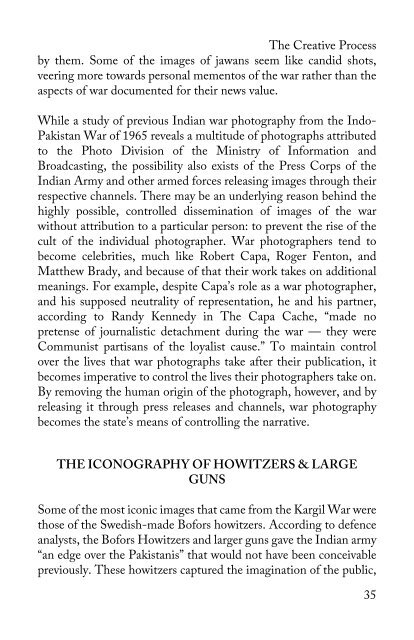The Creative Process: The Arts of War (Spring 2017)
The Creative Process is The Mumbai Art Collective's flagship magazine.
The Creative Process is The Mumbai Art Collective's flagship magazine.
You also want an ePaper? Increase the reach of your titles
YUMPU automatically turns print PDFs into web optimized ePapers that Google loves.
<strong>The</strong> <strong>Creative</strong> <strong>Process</strong><br />
by them. Some <strong>of</strong> the images <strong>of</strong> jawans seem like candid shots,<br />
veering more towards personal mementos <strong>of</strong> the war rather than the<br />
aspects <strong>of</strong> war documented for their news value.<br />
While a study <strong>of</strong> previous Indian war photography from the Indo-<br />
Pakistan <strong>War</strong> <strong>of</strong> 1965 reveals a multitude <strong>of</strong> photographs attributed<br />
to the Photo Division <strong>of</strong> the Ministry <strong>of</strong> Information and<br />
Broadcasting, the possibility also exists <strong>of</strong> the Press Corps <strong>of</strong> the<br />
Indian Army and other armed forces releasing images through their<br />
respective channels. <strong>The</strong>re may be an underlying reason behind the<br />
highly possible, controlled dissemination <strong>of</strong> images <strong>of</strong> the war<br />
without attribution to a particular person: to prevent the rise <strong>of</strong> the<br />
cult <strong>of</strong> the individual photographer. <strong>War</strong> photographers tend to<br />
become celebrities, much like Robert Capa, Roger Fenton, and<br />
Matthew Brady, and because <strong>of</strong> that their work takes on additional<br />
meanings. For example, despite Capa’s role as a war photographer,<br />
and his supposed neutrality <strong>of</strong> representation, he and his partner,<br />
according to Randy Kennedy in <strong>The</strong> Capa Cache, “made no<br />
pretense <strong>of</strong> journalistic detachment during the war — they were<br />
Communist partisans <strong>of</strong> the loyalist cause.” To maintain control<br />
over the lives that war photographs take after their publication, it<br />
becomes imperative to control the lives their photographers take on.<br />
By removing the human origin <strong>of</strong> the photograph, however, and by<br />
releasing it through press releases and channels, war photography<br />
becomes the state’s means <strong>of</strong> controlling the narrative.<br />
THE ICONOGRAPHY OF HOWITZERS & LARGE<br />
GUNS<br />
Some <strong>of</strong> the most iconic images that came from the Kargil <strong>War</strong> were<br />
those <strong>of</strong> the Swedish-made B<strong>of</strong>ors howitzers. According to defence<br />
analysts, the B<strong>of</strong>ors Howitzers and larger guns gave the Indian army<br />
“an edge over the Pakistanis” that would not have been conceivable<br />
previously. <strong>The</strong>se howitzers captured the imagination <strong>of</strong> the public,<br />
35



